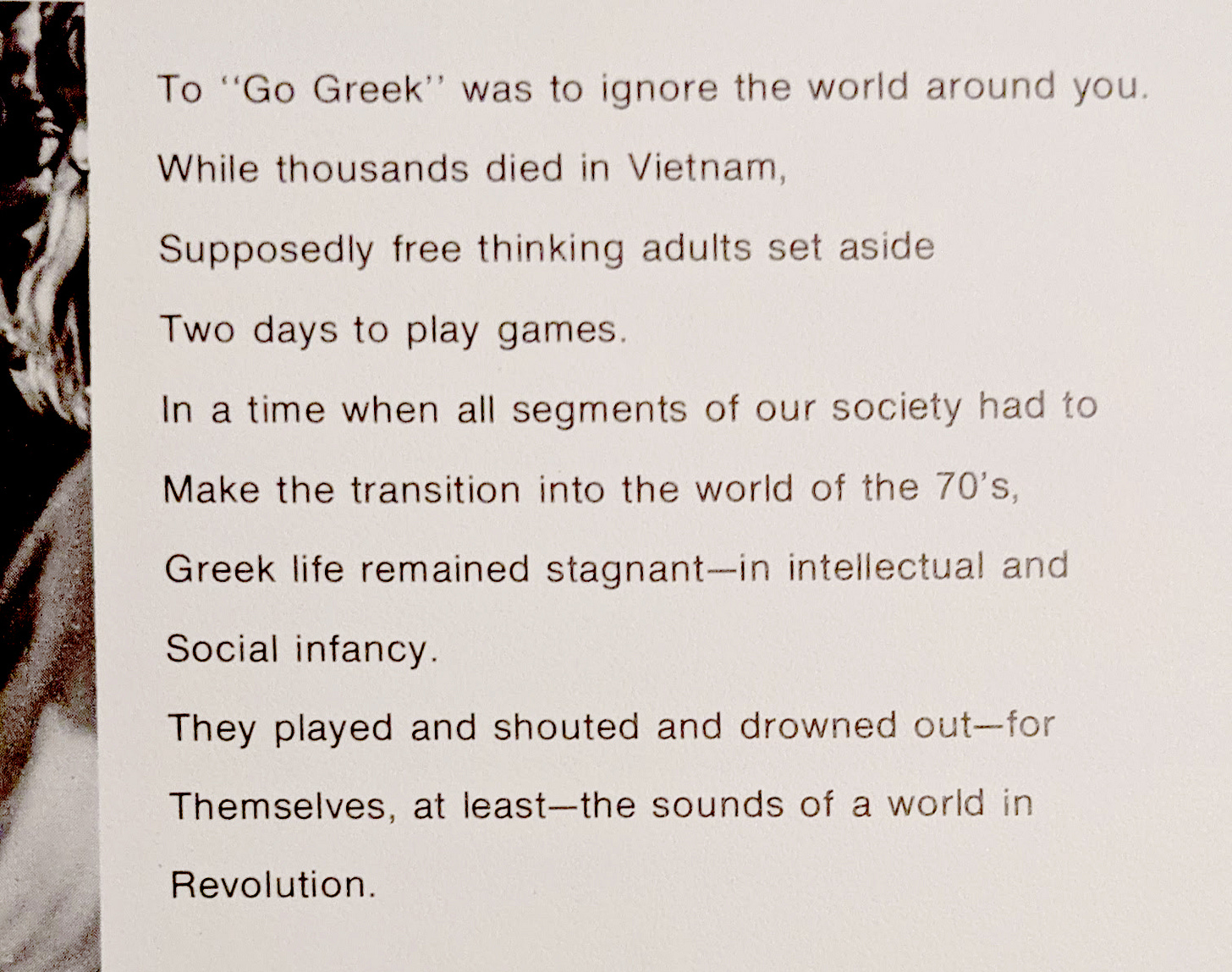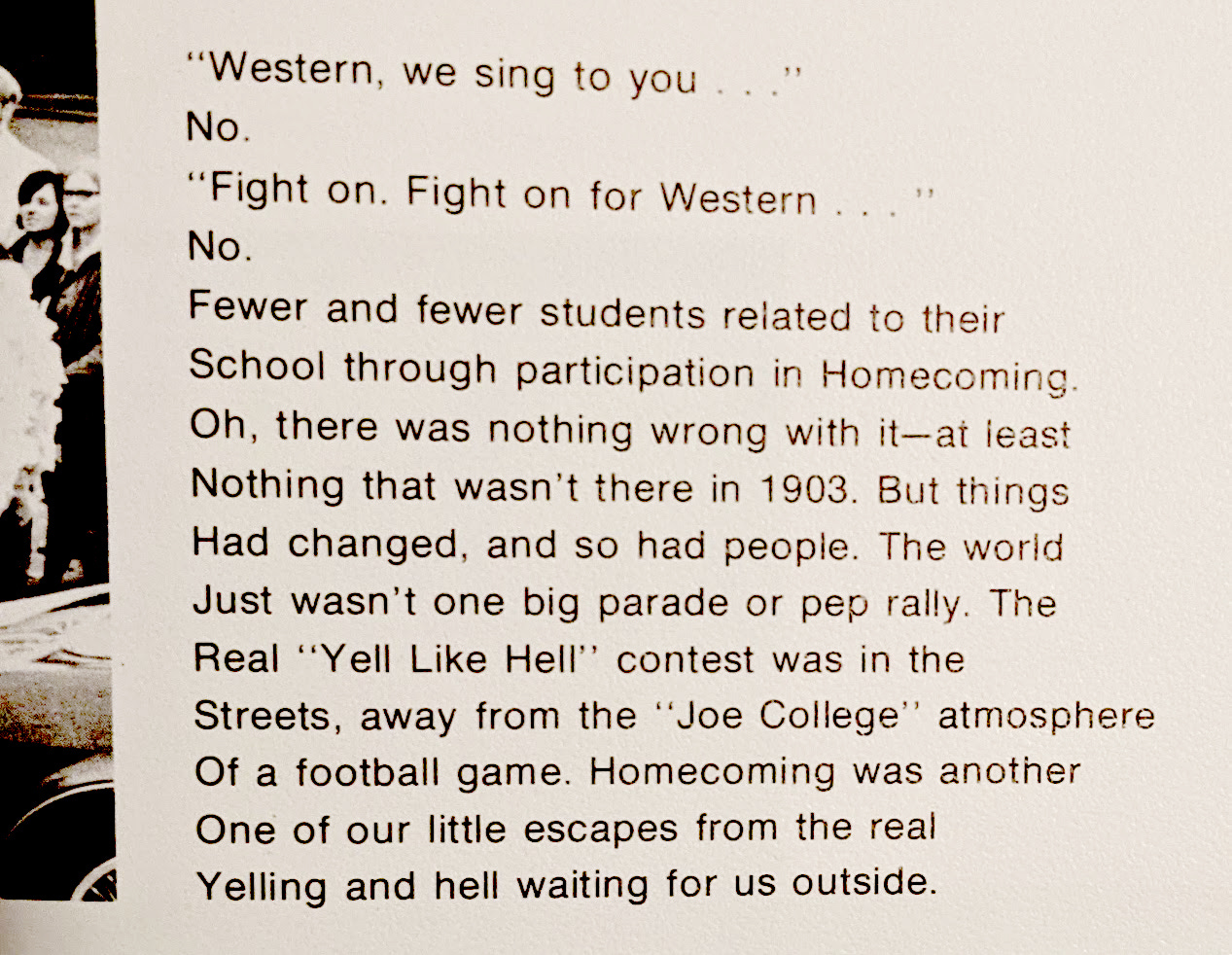… and I’m back! Over the past week, I traveled out of state to visit family, which was delightful, and not just because I was able to get my grubby little hands on all of my family members’ yearbooks (although that was definitely part of the fun). On my way there, I took a pit stop in Ann Arbor — you may remember me mentioning a piece I wanted to see at UMMA in my previous post. I thought it would make for some easy content, like “Oh look, here’s a work of art that uses collaged yearbook pages! Neat!” But instead, surprise surprise, Diptych on Vietnam by Michael Joseph led me down a week-long rabbit hole. Ready to dive in the pit with me? Let’s go!
This is Diptych on Vietnam by Michael Joseph.
It’s huge: my eyeline meets the masked figure’s knees. From afar, the piece is striking — the blue figure and the spray-painted “gas” that surrounds him are the only elements immediately visible. When examined more closely, the hazy, almost placid image snaps into stark focus, and from it emerges chaos. Graphite and colored pencil sprawl across the canvas, with large and loose cursive letters spelling out “The Class of 65” at the top of the painted piece. Illegible words become white noise in the smoke that envelops the figure.
The larger panel contextualizes the piece below without overpowering it: the organic, free-flowing lines above are built on a solid foundation of faces in neat black columns. When the viewer finally gets close enough to recognize the dark stripes as individual people, it’s already clear that this piece is about war and loneliness and panic. But those collaged yearbook pages deliver the final devastating blow.
Scrawled across a handful of youthful, smiling faces are the letters “K.I.A.” (“Killed In Action”) and “W.I.A.” (“Wounded In Action.”) It’s not specified how many of these hopeful high school grads were drafted; the harm, the carnage, the loss of life is the focus here.
By flattening these pages through a Xerox-like transfer process, they become one solid, complete object. Written signatures become indistinguishable from typeset text, images and words and handwriting melting together into one immutable layer of history. This makes the markings on top, the blue and orange and purple scribbles, feel thoughtless and crass — an act of vandalism, a defilement of these boys’ futures. They feel more than tragic: they feel hopelessly permanent and deeply wrong.
Looking at these photos up close, the phrase that comes to mind first is “wasted potential.” The Vietnam War took so many young lives — it snatched up kids like these who had dreams and aspirations and personalities and pastimes. Peter was in Glee Club; John ran cross-country; Robert played football; Paul was in the Drama Club. What would their college yearbook portraits have looked like? What could they have become?
After experiencing Joseph’s piece, I was compelled to look back through a Western Michigan University yearbook I nabbed a couple of weeks ago. I’m not usually interested in college yearbooks because they don’t really give the reader an accurate illustration of the student body (many schools require individuals to pay for their portrait to be included) and they’re rarely signed. What drew me to this specific volume of the Brown and Gold was the sheer seventies-ness of it: photos full of bell-bottoms and beards, free love, and “the Age of Aquarius” (yes, it actually quotes Hair).
It all seemed laughable, beyond parody. But after my visit to UMMA, I saw the book with new eyes. This represented a life the boys on Joseph’s high school yearbook pages would never experience; a generation of youth with two very different fates. Exploring this 1970 yearbook has allowed me to better understand the experience of college students during the draft lottery: the outrage, the powerlessness, the guilt they experienced knowing their education was shielding them from the atrocities of an unjust war.
The yearbook staff dedicated large chunks of the volume to calling out the injustices they saw all around them. Here are some of my favorite passages:
This last quote refers to a 1969 speech given by then-Vice President Spiro Agnew, who decried universities as radical indoctrination centers and college protestors as delusional intellectuals. (Afterward, many self-proclaimed “snobs” adopted his comment as a badge of honor, even wearing actual badges to boast their snobbery.) Even with the President and Vice President publically against them, college students like these spoke out against the war in any way they could: they marched, they wrote letters, and, yes, they published yearbooks.
Honestly, the whole book is incredibly well-designed and well-written, if cloyingly earnest at times. I wish I could scan and share every page, but here’s a collection of my favorite spreads:
I know I’m just dipping my toe into this subject, and there’s so much more left to learn about teenage life during the Vietnam War. But I think this week, I was able to have a brand new yearbook experience: both Michael Joseph’s Diptych and the 1970 Brown and Gold acted as windows into the lives of a generation of youth, rather than into the life of just a few individuals. And that collective experience has moved me more than I could ever have expected.
If you’re in southeast Michigan, I encourage you to check out Diptych on Vietnam and all the other great works at UMMA!














